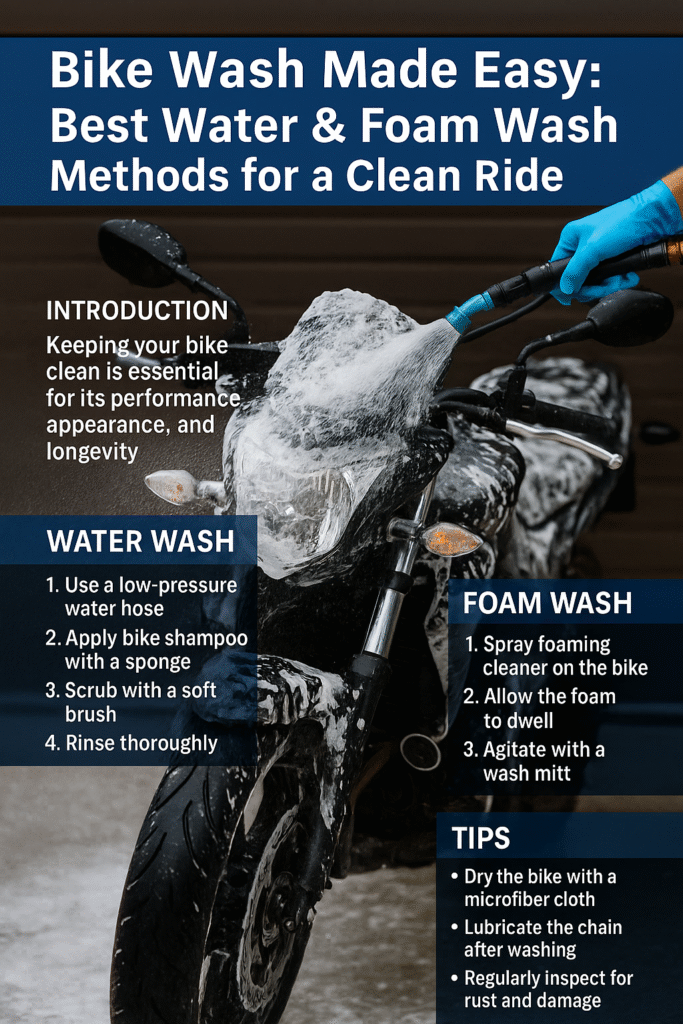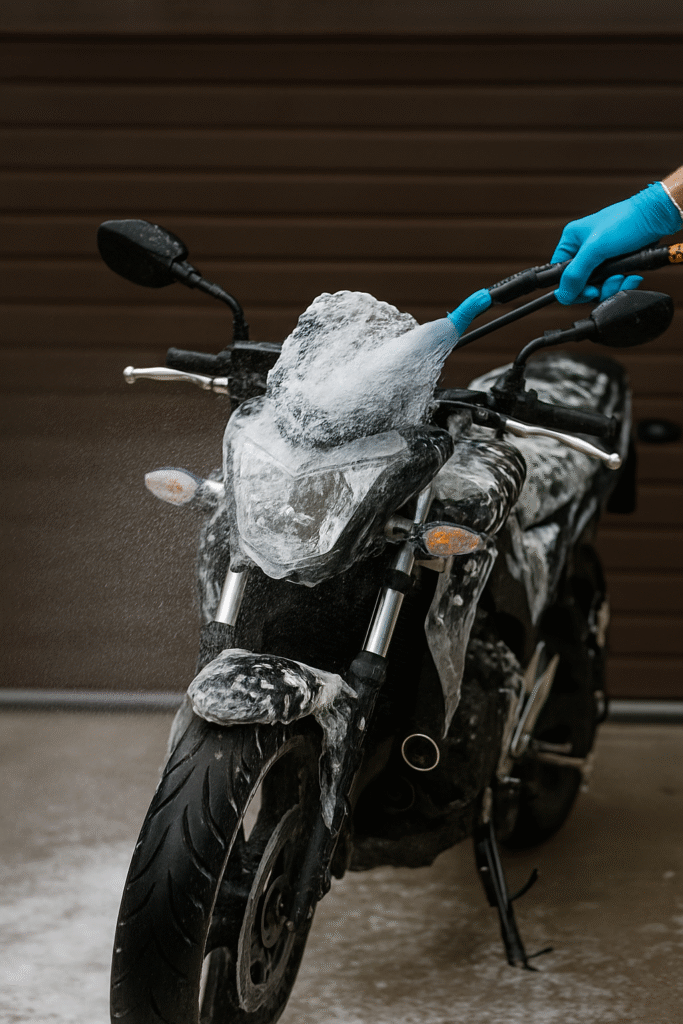Keeping your bike clean with a proper Bike Wash routine is essential for maintaining its performance, appearance, and resale value. Whether you’re using water or foam wash techniques, the right method will prevent corrosion, ensure smoother rides, and keep your machine looking its best.
In this guide, we’ll walk you through how to do a water wash and foam wash correctly, plus tips, tools, common mistakes to avoid, and how often you should wash your bike.
Why a Regular Bike Wash Is Essential
Every time you ride, your bike picks up dirt, grime, oil, and pollution — especially in urban and off-road environments. Over time, this debris damages paint, affects cooling, and wears down moving parts.
A regular bike wash isn’t just cosmetic — it helps:
- Prevent rust and corrosion
- Maintain fuel efficiency
- Ensure smoother gear shifts
- Extend chain and sprocket life
- Keep brakes and engine clean
Tools & Products You Need for a Proper Bike Wash
Before starting your wash, gather these tools:
- Low-pressure water hose or bucket
- pH-neutral bike shampoo (like Muc-Off Cleaner)
- Foam gun or foam spray (for foam wash)
- Microfiber cloths
- Soft-bristle brushes
- Chain cleaner and lubricant
- Plastic bags (to cover electrical parts)
💡 Pro Tip: Use dedicated motorcycle cleaning products, not dish soap, which can damage paint and rubber.
Step-by-Step Bike Water Wash Method
Step 1: Park & Cool Down
Park your bike in a shaded area and wait for the engine to cool completely.
Step 2: Rinse Off Loose Dirt
Use a low-pressure hose to remove top-layer dust and mud. Avoid high-pressure water on chains, brakes, or electrical parts.
Alt: bike water wash in progress using low-pressure hose
Step 3: Lather With Bike Shampoo
Mix a bike-friendly shampoo with water and apply with a wash mitt or sponge. Scrub gently from top to bottom.
Step 4: Detail the Hard Parts
Use soft brushes for rims, engine fins, and underbody. Be thorough but gentle to avoid scratches.
Step 5: Final Rinse
Wash off all the soap completely. Residue can leave streaks or cause paint damage.
Step 6: Dry the Bike
Wipe down with a dry microfiber cloth. Focus on joints, mirrors, and under the seat to avoid trapped moisture.
Step 7: Chain Care
Clean the chain with a degreaser, let it dry, then apply a good quality chain lube. For more info, check our Chain Lubrication Guide.
How to Do a Bike Foam Wash Like a Pro
A bike foam wash uses a special foam gun or bottle to apply thick soap foam, which lifts dirt without heavy scrubbing.
Alt: bike foam wash method with thick cleaning foam
https://images.unsplash.com/photo-1592194996308-7b43878e84a6
Foam Wash Benefits:
- Touchless cleaning = no scratches
- Efficient coverage of large areas
- Preserves delicate paintwork
- Requires less water
Foam Wash Steps:
- Mix foam shampoo with water in a foam gun.
- Spray the foam evenly over the bike.
- Let it sit for 2–3 minutes.
- Lightly agitate stubborn spots with a soft mitt.
- Rinse off thoroughly.
- Dry and lubricate the chain.
👉 Many riders prefer foam washing once every 2 weeks for a professional finish. You can also book a foam wash service if you lack the tools at home.
After-Wash Tips to Protect Your Bike
- Apply spray wax or polish to maintain shine.
- Use anti-rust spray for bolts and metallic joints.
- Cover your bike with a breathable, waterproof cover.
- Wipe your bike down with a dry cloth weekly.
- Check for loose bolts, worn pads, and tire pressure.

Common Mistakes to Avoid During a Bike Wash
- ❌ Using household detergents
- ❌ Spraying high-pressure water on electricals
- ❌ Forgetting to dry the bike
- ❌ Not lubricating the chain after washing
- ❌ Skipping regular washes for months
When to Visit a Professional Wash Center
While home washing works well, consider a professional bike foam wash for:
- Premium motorcycles with matte or custom paint
- Deep degreasing and ceramic coating
- Post-adventure rides or long trips
- Annual detailing before resale
Professionals use advanced tools and trained staff to give your bike a showroom finish without damage. You can also explore our expert cleaning packages for periodic maintenance.
How Often Should You Wash Your Bike?
| Ride Type | Recommended Wash Frequency |
|---|---|
| Daily commuter | Once every 7–10 days |
| Weekend rider | Twice a month |
| Off-roader | After every muddy/dusty ride |
| Monsoon season | Every 3–5 days (rain = dirtier) |
Final Thoughts
A clean bike is a happy bike. Whether you choose a bike water wash or a bike foam wash, staying consistent with your routine will keep your ride smooth, shiny, and problem-free. It also helps maintain its resale value and reduces maintenance costs in the long run.
Alt: clean motorcycle after complete bike wash
So take out that sponge, turn on the water, or get foamy — and give your two-wheeled partner the love it deserves. 🏍️✨
✅ Outbound Links Recap:
✅ Internal Links Recap:
